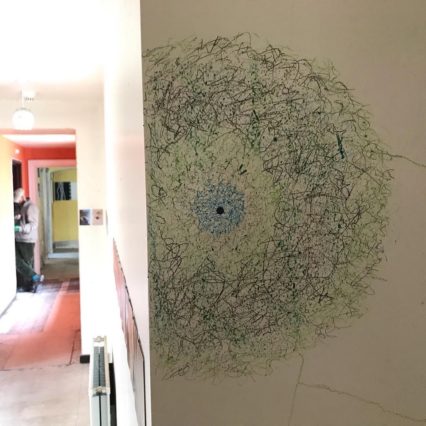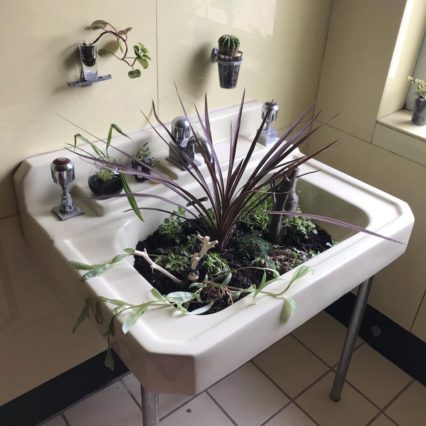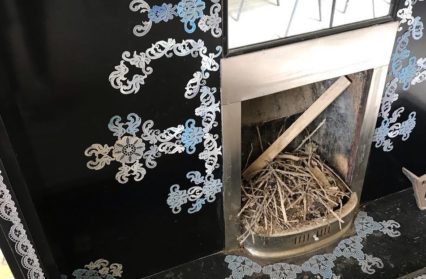James H.F. Lloyd reviews the possibilities of a house – as Plas Bodfa on Anglesey hosts its first exhibition, bringing together an array of installation artists to a unique setting of the Sui Generis exhibition.

Plas Bodfa’s inaugural exhibition Sui Generis displays the tantalising potential of the future artist’s residency and its contributors. A term used by the legal profession for the old country home, Sui Generis means “of its (his, her, their) own kind; in a class by itself; unique”. The exhibition, part of Anglesey’s Art’s Weeks, explores “The Possibilities of a House”. It’s a fitting theme for an old building that has previously been a steak house, residential care home and tapestry business. Plas Bodfa is currently in disrepair after twelve years of abandonment. The house has been gutted or the Sui Generis exhibition, as though each of its previous occupants have taken more from the property than has been given back. The old oak staircase, partially concealed by its previous life as a care home, feels alien in the stripped entrance hall. Many of the walls are bare brick, the floors bare boards. The potential of this beautiful house and gardens is fully exposed.
Julie Upmeyer and Jonathan Lewis bought the property with the intention of creating a space for artists to create and exhibit work, as well as creating a cultural hub and possible holiday lets. They are already planning future exhibitions after this Sui Generis exhibition, utilising the full space the grounds have to offer. This first exhibition before the complete renovation of the building has seen sixty-two artists contribute, each interpreting the theme in their own way.
Some of the installations of Sui Generis directly explore the meandering history of the old house through photos and objects. Recordings of previous tenants recalling memories of a room make the past feel close; a remembrance of what was, while also a call to make new memories. Debbie Budenberg beautifully utilises one of the old bedrooms to express the layered history of the house and the objects that had once been in there. Another installation eagerly translates Plas Bodfa from Welsh as “the place to be”.
Other installations in the Sui Generis exhibition explore more different understandings of the theme to beautiful effect. Georgia Colman’s beautiful pottery was made using textures cast from the building itself, leaving a fossil-like impression on the vessels. The process of making a pot, often repeatedly recycling the same clay, echoed the process of change in the house; the same building becoming different things. Her work demonstrates how place leaves an impression on us and our work.

Ioan Griffith’s window installation at the Sui Generis exhibition used natural light to create seascapes. The light coming through becomes hazy, silhouetting the tiny ships on the narrow line of the horizon. The work is beautiful in its simplicity, nostalgic in a way I can’t quite place. It feels like a projection of a half-forgotten memory slowly recalled. The ability of this installation to change with the weather and light from outside makes it particularly interesting in the way the place is always changing.
Helen Birnbaum explores the human body as a home for a plethora of bacteria, memorialising human infection through ceramics. Detailed models of bacteria like cholera and smallpox are contained in antique boxes, memorabilia of the past.
Amy Sterly and Thom Snell’s Sound Books, a wall of books left open and fluttering in the breeze, highlights the sensuality of a book as opposed to its digital alternative. Locked among the words and pages, the feel and smell and emotion, are housed memories that aren’t so easily felt on its competing medium.
The Sui Generis exhibition also included live performances, of which I saw Charles Gershom and Ed Wright’s Accretion Entropy collaboration; a responsive sound performance using electronic instruments and soundboards. The music was an audio-narrative of Plas Bodfa, the sounds reflecting its unusual shape, its history and location, and the emotions of the people who have passed through there. The music reflected the naked, anxious state of the house, with Gershom layering a foundation of sound that Wright punctuated with both nostalgic and oppositely unnerving sounds. It resonated physically and mentally.
There were many other installations too at the Sui Generis exhibition: poetry, storytelling, painting and photography, music and singing, sculpture and collage. There was a skateboarding performance too, built into what had once been the restaurant. A corridor of lights, a room entirely filled with graffiti; photographs of the Tarlabaşi community of Istanbul. The diversity of talent was brilliant to see in a part of Wales often overlooked, exhibiting both local artists and artists drawn in.
Sui Generis is a first glimpse of what Plas Bodfa can offer, and the beginnings of what will become a hub of artistry and culture. While the presence of the past is very close, the future is what was really exciting about this project; the shell of a house inhabited with possibility.
For more information on Plas Bodfa, visit their website.
James H.F. Lloyd is an avid contributor to Wales Arts Review.



 Enjoyed this article? Support our writers directly by buying them a coffee and clicking this link.
Enjoyed this article? Support our writers directly by buying them a coffee and clicking this link.








